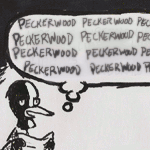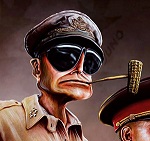|
HEY GAL posted:Spanish-style escuadrons are very strong, as formations--consider the Battle of Rocroi, where a bunch of them repulsed eight French cavalry charges while they were getting bombarded by cannon for hours, and they were still with it enough at the end of the day to surrender on terms rather than just run. What does that say about the accuracy of these cannons? I imagine that such big and deep formations are an artillerist's dream. A ball is not going straight from further away, but it's surely plowing through the ranks and doing some pretty bad damage. If it hits. Velazquez is great.
|
|
|
|

|
| # ? May 9, 2024 15:08 |
|
JaucheCharly posted:What does that say about the accuracy of these cannons? I imagine that such big and deep formations are an artillerist's dream. A ball is not going straight from further away, but it's surely plowing through the ranks and doing some pretty bad damage. If it hits.    Note that the first depiction shows that on rocky ground you can turn the rocks into projectiles to maximize damage, while on clean ground you should focus simply on skipping your shot off the earth into your target. If you get the angle right, you should hit them at about torso level. Incidentally, check this out.   Do you know what they're doing? They're sizing their pieces and making sure they have ammunition to match. It's an important step. HEY GUNS fucked around with this message at 20:40 on Jun 4, 2014 |
|
|
|
I remember reading somewhere that early musketmen and arquebusiers would cast their own ammunition and such pre-battle--artillerymen did that too?
|
|
|
|
Davin Valkri posted:I remember reading somewhere that early musketmen and arquebusiers would cast their own ammunition and such pre-battle--artillerymen did that too?
|
|
|
|
HEY GAL posted:Well, let's pick up our manuals and turn to leaf 158.
|
|
|
|
Are these stone balls? Does the guy in the image with "Sechste Frag" whistle a tune or does he find the barrel sexy? Also, what do the metal chains linked to the carriage do?
|
|
|
|
JaucheCharly posted:Are these stone balls? Edit: Or with transport; you'd sometimes winch the things off the carriages by the dolphins (the loops above the trunions) and put them in wagons, it could help with that. HEY GUNS fucked around with this message at 21:06 on Jun 4, 2014 |
|
|
|
Look at the pics that show the guns from above. What's the purpose of these weird contraptions?
|
|
|
|
JaucheCharly posted:Look at the pics that show the guns from above. What's the purpose of these weird contraptions?
|
|
|
|
Pure guess, but either "don't stand here fucknut" barriers or carriage braces for recoil compensation so it goes straight backwards and then you can wheel the gun back into your nice measured position more easily? The first one does seem to be pegged into the ground in some fashion.
|
|
|
|
My amateur guess is they're for attaching the carriage to a fortification and/or a ship
|
|
|
|
Wasn't chaining the gun carriage hubs together sometimes used to deter cavalry attacks? I'd also guess they'd have something to do with transporting the gun - having to haul one of those things across 16th Century Europe meant you had to get inventive and *really* know your Archimedes.
|
|
|
|
Terrifying Effigies posted:Wasn't chaining the gun carriage hubs together sometimes used to deter cavalry attacks?  quote:I'd also guess they'd have something to do with transporting the gun - having to haul one of those things across 16th Century Europe meant you had to get inventive and *really* know your Archimedes.   When Francis I brought his big pieces over the Alps, his contemporaries flipped their poo poo. As well they should have. Edit: Feel free to download that book legally for free by clicking on the link I provided, the Bavarian State Library says it's OK. HEY GUNS fucked around with this message at 00:16 on Jun 5, 2014 |
|
|
|
People had big butts back in the day.
|
|
|
|
Baloogan posted:People had big butts back in the day. We have fallen from Eden.
|
|
|
|
So I'm halfway through Wedgwood's Thirty Years War and definitely seeing the WWI influence, with a lot of time spent pointing out every missed chance for peace in the early part of the war. The edition I got has an additional introduction where she admits that the book was strongly influenced by when it was written. She also says that after WWII she no longer thinks all war is pointless, but sticks to her guns that this one in particular was. Her writing is great though, and I love how flatly declarative it is. It's refreshing to read a historian that just comes out and says "the Elector of the Palatinate was a goober". While I'm thanking people for book recommendations, thanks to everyone who recommended Shattered Sword. One question that it brings up for me though, is what was Japan's plan to win the war? It's clear to me that they lost the war when the first bomb hit Pearl Harbor, but did the Japanese general staff leave behind any documents detailing what their high level strategy was? Did they have any actual expectation that the US would sue for peace?
|
|
|
|
They expected that the Americans would bunch up everything they had and steam for Japan (just like the Russians did in 1905) and that the Imperial navy would intercept and sink it (as they did to the Russian fleet). Their plan for war was literally called The great Battle Plan. The Americans declined a direct fight until they built up resources. The IJN of 1941 was probably better than the US Navy of 1941, but the US Navy of 1944 was an unstoppable juggernaut. The IJN had a plan, the US Navy had a purpose. A plan can break on an obstacle but a purpose flows over obstacles.
|
|
|
|
HEY GAL posted:
That guy is clearly not sharing the blocks.
|
|
|
|
P-Mack posted:While I'm thanking people for book recommendations, thanks to everyone who recommended Shattered Sword. One question that it brings up for me though, is what was Japan's plan to win the war? It's clear to me that they lost the war when the first bomb hit Pearl Harbor, but did the Japanese general staff leave behind any documents detailing what their high level strategy was? Did they have any actual expectation that the US would sue for peace? The idea was that they'd smash the US Navy at Pearl Harbor, then smash them again at some decisive battle in the future (it kept getting put off when they realized the US just wasn't going to give it to them) and combine it with seizing a large defensive perimeter that would be so costly to take back that the US would eventually sue for peace. That's really one of the big pitfalls of the Midway operation - it wouldn't have appreciably extended the defensive perimeter because it would've been really costly to keep supplied while also being vulnerable to long-range bombing from Pearl Harbor, and it also ended up costing the IJN a bunch of carriers that would have come in really useful in a mobile defense role, heading off any attempts to penetrate the established perimeter (like, say, the Battle of the Eastern Solomons/Santa Cruz)
|
|
|
|
P-Mack posted:So I'm halfway through Wedgwood's Thirty Years War and definitely seeing the WWI influence, with a lot of time spent pointing out every missed chance for peace in the early part of the war. The edition I got has an additional introduction where she admits that the book was strongly influenced by when it was written. She also says that after WWII she no longer thinks all war is pointless, but sticks to her guns that this one in particular was. Kaigun by Evans and Peattie discusses this in excruciating detail. Such excruciating detail that the development of air power and air doctrine got its own sister volume, Sunburst. It's pretty fantastic and similarly readable to Shattered Sword.
|
|
|
|
P-Mack posted:So I'm halfway through Wedgwood's Thirty Years War and definitely seeing the WWI influence, with a lot of time spent pointing out every missed chance for peace in the early part of the war. The edition I got has an additional introduction where she admits that the book was strongly influenced by when it was written. She also says that after WWII she no longer thinks all war is pointless, but sticks to her guns that this one in particular was. I somehow missed this when someone recommended it so thanks. I was just looking for something to get on audible and Thirty Years War just happens to be on there! xthetenth posted:Kaigun by Evans and Peattie discusses this in excruciating detail. Such excruciating detail that the development of air power and air doctrine got its own sister volume, Sunburst. It's pretty fantastic and similarly readable to Shattered Sword. This is not unfortunately. 
|
|
|
|
Kemper Boyd posted:Shields went partially out of fashion because you can't really make a bulletproof shield that's usable. Up until the latter half of the 16th century this is simply not true. Their continued effectiveness against small-caliber weapons (like arquebus) is one of the reasons rodelas remained in use into the 17th century.
|
|
|
Rodrigo Diaz posted:Up until the latter half of the 16th century this is simply not true. Their continued effectiveness against small-caliber weapons (like arquebus) is one of the reasons rodelas remained in use into the 17th century. I was going to ask about this because if modern small arms can effectively be stopped by steel plate a few mm thick, surely it would be even more effective against weapons with relatively lovely armour penetration.
|
|
|
|
|
Slavvy posted:I was going to ask about this because if modern small arms can effectively be stopped by steel plate a few mm thick, surely it would be even more effective against weapons with relatively lovely armour penetration. Most modern small arms can not be stopped by only a few mm of steel. For anything bigger than a pistol you're talking ballpark half an inch of quality steel at 100 yards, assuming standard ball. Get into purpose designed AP in any common rifle caliber and that goes up fast.
|
|
|
|
Slavvy posted:I was going to ask about this because if modern small arms can effectively be stopped by steel plate a few mm thick, surely it would be even more effective against weapons with relatively lovely armour penetration. https://www.youtube.com/watch?v=1QgXuhv7-54&t=38s Where do you get ideas like that from? There's various modern military training videos online, where you can see what happens if you hide from rifle fire behind a tree, bricks, car door etc. Late plate was made to withstand at least pistol shots, and the good quality pieces will often have a test shot made as proof. You can see these dents in museum pieces. I don't know if there's anything to the story that the smith had to wear it when the shot was made.
|
|
|
|
HEY GAL posted:This is 1582, so it could be either. With iron, you can just cast them instead of paying a cannonball-carver, and those guys make bank. A stone ball is lighter than an iron ball of the same size, though, so it takes less powder. He may find the barrel sexy. I have no idea what the various parts of the carriage do or why there's chains on it, probably something to do with hitching. How long does it take someone to carve a cannonball? It seems a bit impractical for something you're going to be firing off a lot.
|
|
|
|
DerLeo posted:How long does it take someone to carve a cannonball? It seems a bit impractical for something you're going to be firing off a lot. How much does modern ordinance cost and how long does it take to manufacture the complex stuff? Even if you're carving near-ish the battlefield you have a lot of time between engagements. Very early cannon also had much longer intervals between firing than the 19th century cannon most people are familiar with
|
|
|
|
What kind of training went into ammunition management, both for artillery and infantry? Were there major battles decided because one side ran out of ammunition before the other? Did soldiers leave the lines briefly to resupply, or did they usually carry enough powder and shot to fight battles?
|
|
|
|
This is a great thread. My reading is only to page 137, so apologies if this question happened to come up in the last 20 or so pages and I didn't catch it. I would like some recommendations for good books / other sources on the militia / American army of the Revolution and early USA. If you can recommend sources particularly discussing firearm culture and the open / concealed carrying of weapons among the general public or the like that'd be great. If it isn't flagrantly obvious, I ask because I'm doing some research for a 2nd Amendment argument. I kind of assume everything I find in a bookstore is going to be some pundit's politically charged screed, but if anyone knows more reasoned or objective sources, it'd be you guys. Extra apologies if this is not really a military history topic.
|
|
|
|
Cyrano4747 posted:How much does modern ordinance cost and how long does it take to manufacture the complex stuff? Even if you're carving near-ish the battlefield you have a lot of time between engagements. Very early cannon also had much longer intervals between firing than the 19th century cannon most people are familiar with And any shot from the other side that missed can probably be shot back by your own cannons.
|
|
|
|
ArchangeI posted:And any shot from the other side that missed can probably be shot back by your own cannons. Ehhh, I don't know about that. Stone shot has a tendency to shatter from what I understand. Even if it was as durable as iron shot it's going to be buried in whatever geographical feature stopped it (and good luck finding that) or it's going to be located anywhere from ~a thousand yards to a couple of miles in the direction of "that way."
|
|
|
|
My stepfather used to fire the cannons at Louisbourg Fortress (as a reenactor, he's not that old) and he said that after they forged a new one they were always concerned that the cannon might explode on the first shot. Obviously it helped that they weren't actually shooting a ball and using less powder than a full charge, but was this a common problem? Did a ruptured cannon typically kill the firing crew?
|
|
|
|
Cyrano4747 posted:Very early cannon also had much longer intervals between firing than the 19th century cannon most people are familiar with AATREK CURES KIDS posted:What kind of training went into ammunition management, both for artillery and infantry? Were there major battles decided because one side ran out of ammunition before the other? Did soldiers leave the lines briefly to resupply, or did they usually carry enough powder and shot to fight battles? I am not familiar with any battles decided because one side ran out of ammunition, but it's possible that it could have happened. HEY GUNS fucked around with this message at 19:28 on Jun 5, 2014 |
|
|
|
AATREK CURES KIDS posted:My stepfather used to fire the cannons at Louisbourg Fortress (as a reenactor, he's not that old) and he said that after they forged a new one they were always concerned that the cannon might explode on the first shot. Obviously it helped that they weren't actually shooting a ball and using less powder than a full charge, but was this a common problem? Did a ruptured cannon typically kill the firing crew? Also, the proofing shot should have been done at the foundry. That's been standard practice since the middle ages. Edit: Rodrigo Diaz knows more about metal than I do, so he might have more to say about this. HEY GUNS fucked around with this message at 17:53 on Jun 5, 2014 |
|
|
|
HEY GAL posted:Also, the proofing shot should have been done at the foundry. That's been standard practice since the middle ages. Maybe it was and the cannonneers at Louisbourg didn't know that. They didn't and still don't have anything you'd call extensive guild-like training. My stepdad was a baker and one day they told him "w'ill thair, by, we need 'oon to fair tha' cannon todee" because one of the cannon guys quit suddenly, so he got a crash course. I loved the stuff you wrote earlier about how early on, soldiers saw the cannoneers as something a bit like wizards.
|
|
|
|
P-Mack posted:Her writing is great though, and I love how flatly declarative it is. It's refreshing to read a historian that just comes out and says "the Elector of the Palatinate was a goober".   Sorry, bro. You were out of your depth.
|
|
|
|
Here's a a booklet the anti-British "American Truth Society" published before the US entry into WWI based off the "testimony" of an American deserter from the British Army. Besides the propaganda it makes for interesting reading on its own. He ends up at Galipoli https://openlibrary.org/books/OL23663912M/The_revelations_of_an_American_citizen_in_the_British_army Posting some of the more interesting parts below.                 
|
|
|
|
P-Mack posted:So I'm halfway through Wedgwood's Thirty Years War and definitely seeing the WWI influence, with a lot of time spent pointing out every missed chance for peace in the early part of the war. The edition I got has an additional introduction where she admits that the book was strongly influenced by when it was written. She also says that after WWII she no longer thinks all war is pointless, but sticks to her guns that this one in particular was.
|
|
|
|
HEY GAL posted:Oh yeah--also, it's out of date in that we're all fine with the Empire now. Nobody is going to castigate it any more for not being "like a real state," whatever that means, and we are newly appreciative of its variety and its stability. It is what it is. Deal with it. Yeah, I notice there's a lot of places where she laments how this or that fatally impeded the formation of a true German nation, with a more or less unspoken assumption that the modern ethnicity-based nation state is the natural evolution of government. I remember when I was in college taking a few courses in 20th century history, it felt like there was a similar reappraisal going on towards Austria-Hungary. It guess with the wars and ethnic cleansing in the former Yugoslavia fresh in everyone's mind, there was a renewed appreciation for a multi-ethnic state that managed to chug along for a decent run without open warfare. Can anyone tell me if this is a real historiographical trend or just my professors?
|
|
|
|

|
| # ? May 9, 2024 15:08 |
|
Austria hungry was a multi-ethnic state in the same way that pre- E: thinking about it I was way too generous with years for the US on that Raskolnikov38 fucked around with this message at 02:11 on Jun 6, 2014 |
|
|


































